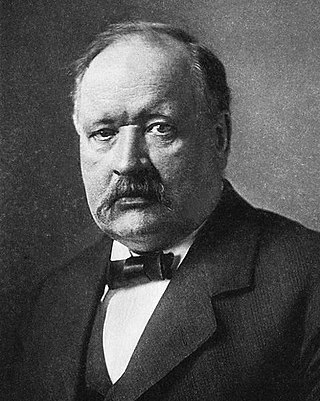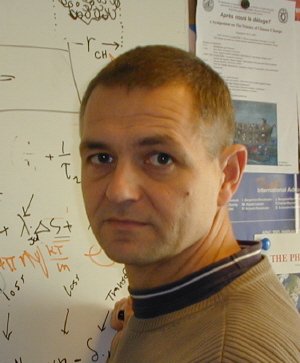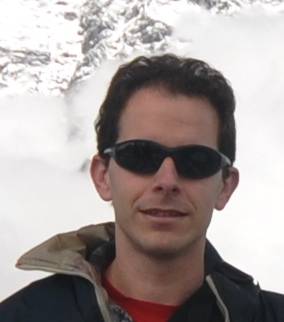
Svante August Arrhenius was a Swedish scientist. Originally a physicist, but often referred to as a chemist, Arrhenius was one of the founders of the science of physical chemistry. He received the Nobel Prize for Chemistry in 1903, becoming the first Swedish Nobel laureate. In 1905, he became the director of the Nobel Institute, where he remained until his death.

Climate variability includes all the variations in the climate that last longer than individual weather events, whereas the term climate change only refers to those variations that persist for a longer period of time, typically decades or more. Climate change may refer to any time in Earth's history, but the term is now commonly used to describe contemporary climate change, often popularly referred to as global warming. Since the Industrial Revolution, the climate has increasingly been affected by human activities.

Cosmic rays or astroparticles are high-energy particles or clusters of particles that move through space at nearly the speed of light. They originate from the Sun, from outside of the Solar System in our own galaxy, and from distant galaxies. Upon impact with Earth's atmosphere, cosmic rays produce showers of secondary particles, some of which reach the surface, although the bulk are deflected off into space by the magnetosphere or the heliosphere.

In astronomy, the interstellar medium (ISM) is the matter and radiation that exist in the space between the star systems in a galaxy. This matter includes gas in ionic, atomic, and molecular form, as well as dust and cosmic rays. It fills interstellar space and blends smoothly into the surrounding intergalactic space. The energy that occupies the same volume, in the form of electromagnetic radiation, is the interstellar radiation field. Although the density of atoms in the ISM is usually far below that in the best laboratory vacuums, the mean free path between collisions is short compared to typical interstellar lengths, so on these scales the ISM behaves as a gas (more precisely, as a plasma: it is everywhere at least slightly ionized), responding to pressure forces, and not as a collection of non-interacting particles.

The solar cycle, also known as the solar magnetic activity cycle, sunspot cycle, or Schwabe cycle, is a nearly periodic 11-year change in the Sun's activity measured in terms of variations in the number of observed sunspots on the Sun's surface. Over the period of a solar cycle, levels of solar radiation and ejection of solar material, the number and size of sunspots, solar flares, and coronal loops all exhibit a synchronized fluctuation from a period of minimum activity to a period of a maximum activity back to a period of minimum activity.
Sallie Louise Baliunas is a retired astrophysicist. She formerly worked at the Center for Astrophysics | Harvard & Smithsonian and was the Deputy Director of the Mount Wilson Observatory from 1991 to 2003.

Global dimming is a decline in the amount of sunlight reaching the Earth's surface, a measure also known as global direct solar irradiance. It was observed soon after the first systematic measurements of solar irradiance began in the 1950s, and continued until 1980s, with an observed reduction of 4–5% per decade, even though solar activity did not vary more than the usual at the time. Instead, global dimming had been attributed to an increase in atmospheric particulate matter, predominantly sulfate aerosols, as the result of rapidly growing air pollution due to post-war industrialization. After 1980s, reductions in particulate emissions have also caused a "partial" reversal of the dimming trend, which has sometimes been described as a global brightening. This reversal is not yet complete, and it has also been globally uneven, as some of the brightening over the developed countries in the 1980s and 1990s had been counteracted by the increased dimming from the industrialization of the developing countries and the expansion of the global shipping industry, although they have also been making rapid progress in cleaning up air pollution in the recent years.
Nephology is the study of clouds and cloud formation. British meteorologist Luke Howard was a major researcher within this field, establishing a cloud classification system. While this branch of meteorology still exists today, the term nephology, or nephologist is rarely used. The term came into use at the end of the nineteenth century, and fell out of common use by the middle of the twentieth. Recently, interest in nephology has increased as some meteorologists have begun to focus on the relationship between clouds and global warming, which is a source of uncertainty regarding "estimates and interpretations of the Earth’s changing energy budget."
This is a list of meteorology topics. The terms relate to meteorology, the interdisciplinary scientific study of the atmosphere that focuses on weather processes and forecasting.
The faint young Sun paradox or faint young Sun problem describes the apparent contradiction between observations of liquid water early in Earth's history and the astrophysical expectation that the Sun's output would be only 70 percent as intense during that epoch as it is during the modern epoch. The paradox is this: with the young Sun's output at only 70 percent of its current output, early Earth would be expected to be completely frozen, but early Earth seems to have had liquid water and supported life.
A Forbush decrease is a rapid decrease in the observed galactic cosmic ray intensity following a coronal mass ejection (CME). It occurs due to the magnetic field of the plasma solar wind sweeping some of the galactic cosmic rays away from Earth. The term Forbush decrease was named after the American physicist Scott E. Forbush, who studied cosmic rays in the 1930s and 1940s.

Henrik Svensmark is a physicist and professor in the Division of Solar System Physics at the Danish National Space Institute in Copenhagen. He is known for his work on the hypothesis that fewer cosmic rays are an indirect cause of global warming via cloud formation.

Nir Joseph Shaviv is an Israeli‐American physics professor. He is professor at the Racah Institute of Physics of the Hebrew University of Jerusalem.
Eigil Friis-Christensen was a Danish geophysicist specializing in space physics.
The Cloud Mystery is a documentary by Danish director Lars Oxfeldt Mortensen. It explores the theory by Danish scientist Henrik Svensmark on how galactic cosmic rays and solar activity affects cloud cover, and how this influences the Earth's climate. Also known as Klimamysteriet in Danish.

The Deniers is a 2008 book by Lawrence Solomon, a Canadian environmentalist and writer. Subtitled "The world-renowned scientists who stood up against global warming hysteria, political persecution, and fraud," the book draws attention to a number of scientists and others who, according to Solomon, have advanced arguments against what he calls the "alarmist" view of global warming, as presented by Al Gore, the Intergovernmental Panel on Climate Change (IPCC), the mainstream media, and others. The book is based on a series of columns Solomon wrote for Canada's National Post. It has been criticized for misquoting the scientists it featured.

Cosmics Leaving Outdoor Droplets (CLOUD) is an experiment being run at CERN by a group of researchers led by Jasper Kirkby to investigate the microphysics between galactic cosmic rays (GCRs) and aerosols under controlled conditions. This is a fixed-target experiment that began operation in November 2009, though it was originally proposed in 2000.

The history of the scientific discovery of climate change began in the early 19th century when ice ages and other natural changes in paleoclimate were first suspected and the natural greenhouse effect was first identified. In the late 19th century, scientists first argued that human emissions of greenhouse gases could change Earth's energy balance and climate. The existence of the greenhouse effect, while not named as such, was proposed as early as 1824 by Joseph Fourier. The argument and the evidence were further strengthened by Claude Pouillet in 1827 and 1838. In 1856 Eunice Newton Foote demonstrated that the warming effect of the sun is greater for air with water vapour than for dry air, and the effect is even greater with carbon dioxide.

Michael Lockwood FRS is a Professor of Space Environment Physics at the University of Reading.

Patterns of solar irradiance and solar variation have been a main driver of climate change over the millions to billions of years of the geologic time scale.















